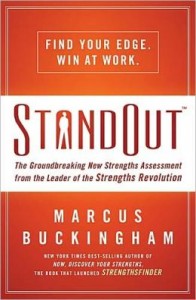Here’s a snippet from a live presentation we did for the Chicago Chapter of the American Society for Training and Development. The topic was Change Management. The Interactors are Dan Feldt and Ta-Tanisha Jordan; I’m facilitating. It was a lively crowd!
11 ways trainers can create terrific role plays
Recently, I had some exciting conversations with people who are trying to create more valuable role plays within their organizations. Talking with them reminded me of this article I wrote for the ASTD magazine Training Today a few years back. It’s a compilation of many things Dan and I have learned over our years of creating interactive learning, adapted for trainers who don’t have professional actors to work with, as we do. I’m reposting the article with permission.
You know that role plays are a wonderful tool for turning theory into practice. They can answer that crucial question, “How does this apply to me?” By giving learners a chance to try out new behaviors in a controlled setting, they can jump-start the application of new learning back on the job. They get people out of their chairs and into action.
So why do so many learners hate role plays? You’ve seen it happen: participants groan when a role play is announced. You can’t get a volunteer, so you have to force someone to come up. The role players are too easy on each other, or they give up too soon – or they just undermine the whole exercise with joking or hostility. What’s going on here?
It’s simple: they’re afraid they’re going to make fools of themselves. As a trainer, you know that most people get anxious when they have to get up in front of a group. They’re afraid they’ll be judged. When that group consists of their peers and co-workers, it feels even riskier. And when they’re not sure what they’re supposed to be doing, that anxiety goes sky-high.
You can reduce the risk of role plays. You can’t take away people’s performance anxiety, but you can minimize it through the way you design, set up, and facilitate role plays. You can create an atmosphere of humor and experimentation, and you can ensure success for all participants – no matter what mistakes they make.
Here are 11 ways to make role plays work for you. We’ve divided these tips into the three phases of creating a role play: Design (how you structure the exercise), Instructions (how you explain the exercise to participants), and Facilitation (how you work with the role players as the exercise is taking place).
Design:
- Be specific. Most role plays fail because they’re too general, and people don’t know what to do. Choose the circumstances of the role play carefully. Fill in lots of detail. For example, if it’s a customer-service training, don’t just ask someone to play a complaining customer. Tell the role-players exactly what the issue is: “You’re a credit-card customer who asked last month to have an erroneous charge removed from her bill. You just got the new bill, and the charge is still there.” And to the person playing the customer service rep: “Two people are out sick, and you’re covering for them, even though you should have gone to lunch a half-hour ago. The last person you talked to hung up on you.” This level of detail helps role players believe in the action. They’re less likely to be distracted by their own nerves or by others’ reactions.
- Make the role play situation important to the characters. The stakes should be high. (For example, a valuable employee is ready to quit because his manager never recognizes his achievements. The manager already has been warned by her boss about too much turnover in her department.) When the outcome is important to the characters, the exercise has more energy and interest for the role players and for those watching.
- Target the learning points. Make sure the situation you choose will make the role players deal with the behavior you want to teach. Because new learning feels uncomfortable, most role players will try to avoid acting it out. Close the escape hatches by picking a situation that must be solved by putting the learning points into practice.
- Focus on a small, important piece of behavior. Don’t try to do too much in a single role play. If you’re training people in a process, work it section by section (for example, in sales training, focus on establishing rapport, then on asking probing questions, etc. – perhaps with different participants playing the salesman in each section).
- Don’t be afraid of “negative models.” You can inject a lot of humor – and learning – into a workshop by asking people to “do everything wrong.” For example, in the customer service situation, ask the person playing the rep to come up with three bad ways to handle the complaining customer (such as sounding bored, using sarcasm, and shouting at her), and then let the participants discuss why those approaches didn’t work – the consequences of not using the new learning. You can generate a lot of energy with this exercise, and the humor helps break the ice for further role playing.
Instructions:
- Take role players off the hook. Tell them, “You’re not you in this role play, you’re somebody else just like you.” Refer to the character by another name, not the role player’s name. Creating distance between the character and the self means participants don’t have to own any errors they make – they’re not really “their” mistakes. Sometimes it helps to set role plays at a fictional company similar to the real one.
- Strive for a better – not a perfect – interaction. Let participants know that you’ll applaud any success, even a small one.
- Bring a sense of fun to the exercise. Keep it light. People learn better through humor, liveliness and enjoyment.
- Share the risk. Let role players work in teams, sharing solutions and coaching each other. Have the team come up to the front, so the person who is actually doing the role play can turn to his team for advice. Have team members replace each other in the role play, as in tag-team wrestling, so no one has to do the entire exercise by himself.
Facilitation:
- Applaud. Praise and validate the role players’ work. Thank them for their contribution. Point out where they used the learning points and how it led to a successful outcome. Applaud them for taking the risk of role playing.
- When “failures” happen, focus on the process rather than the person. When role players don’t follow the learning points, say (for example), “Well, that certainly put him in his place. What might be some of the drawbacks to handling it that way?” Discuss the behaviors. Have the role players try the same situation again, with suggestions from other participants. Thank the role players for providing good material for discussion. After all, the whole group will learn from things that don’t work out, as well as from those that do.
Role plays can be a great teaching tool, with your help. You can design, introduce and facilitate them so learners
- know what they’re supposed to be doing
- aren’t afraid of being judged
- feel free to experiment and have fun.
With less anxiety and more targeted learning, who knows? Maybe role plays will become your company’s favorite learning technique.
Interface or face-to-face learning?
What can we as learning and development professionals learn from the decision of Yahoo’s CEO, Marissa Mayer, to end the work-from-home policy for 200 Yahoo employees? In explaining her decision she said, “people are more productive when they’re alone,” and then continued, “but they’re more collaborative and innovative when they’re together. Some of the best ideas come from pulling two different ideas together.” It would be wise to keep her words in mind when developing learning programs.
Marissa Mayer was a rising star at Google before she became Yahoo’s CEO. Yahoo and Google are two companies whose existence depends on the sharing of information over the Internet. However, she’s keenly aware of the limitations of the platform. People are more productive alone when consuming information, understanding concepts, memorizing lists and procedures – all necessary to do their jobs effectively. But when it comes time to use this knowledge in creative applications, employees need to come together face-to-face to pull different ideas together.
Here’s where learning professionals can use Ms. Mayer’s insight. We can also use this blended approach to maximize the effectiveness of our program design. We need to take advantage of both the interface and the face-to-face. Learners can work independently to absorb knowledge and come together in the classroom to apply it in innovative ways.
Finally, when we bring participants together who have gained information from the e-learning portion of the training, we need to refocus their face-to-face time. Instead of facing the facilitator, participants need to face each other and through experiential exercises pull ideas together and make the learning their own.
Let’s keep in mind the reason behind Ms. Mayer’s decision. She said, ‘I don’t want to change [Yahoo’s] culture. I want to amplify its greatness.” Let’s use the strengths of both e-learning and the face-to-face classroom to do the same for learning transfer.
How to deal with stage fright
Excellent article on stage fright and what you can do about it. The author, Mikael Cho, talks about how adrenaline and the fight-or-flight syndrome get in the way when we’re getting ready for a presentation (or even a difficult conversation).
I teach a class on adrenaline flooding, using material from Conflict Unraveled (I’m a certified instructor).
Along with Cho’s suggestion of slow breathing, I’d recommend adding some strong large-muscle movement to help disperse adrenaline. Climb a few flights of stairs, for example, or lean against a wall and use your legs to push forcefully against it.
And don’t forget the best way to put yourself at ease: practice! As Cho says,
We’ve all heard the saying, “practice makes perfect.” The main benefit of practice is to increase your familiarity of a given task. As this familiarity increases, feelings of anxiety decrease, and have less of a negative impact on performance. In other words, the more comfortable you are with your presentation, the anxiety you feel about speaking in public.
I’d add: when actors rehearse, they use the time to explore the possibilities of a scene, not to repeat it mindlessly. So even in practice, keep coming to the task as if for the first time. Discover unexpected meanings and new ways of expressing your ideas. Then you’ll be ready for surprises when it’s time to do it for real.
And breathe!
8 ways to mismanage change
 We’ve been doing a lot of programs on change management lately. Here’s a piece I wrote for the Southeast Wisconsin ASTD newsletter.
We’ve been doing a lot of programs on change management lately. Here’s a piece I wrote for the Southeast Wisconsin ASTD newsletter.
Leaders don’t set out to do a bad job helping employees handle change. But you’d be surprised at how often they end up doing just that. Here’s how to insure that you fail miserably:
- Explain it once and be done with it. Whether it’s a merger, a reorganization, or a change in work assignments, tell people – then drop the subject. They heard you. Why go over it again and again?
- Use vague terminology. Don’t be specific about what will change. Use clichés like “quality driven” and “flatter organizational structure.” Make sure only top managers know the details.
- Don’t talk about the purpose behind change. Employees wouldn’t understand, anyway. Besides, they want to keep their jobs, so they’ll just do as they’re told.
- Dismiss people’s feelings. They’re overreacting. Nobody promised them a rose garden. Change is coming, and there’s nothing they can do about it. If you ignore all that messy emotion, it will go away.
- Disregard the past. No matter how things worked before, it’s over now. The new ways will be better; why else would top management have come up with them? Insist that people focus only on the future. They’ll soon forget their sense of loss.
- Don’t answer questions. People will come up with their own ideas about what’s going to happen. Let them – it will keep them busy during the transition. And crazy rumors keep people on their toes.
- Don’t allow doubt or confusion. Make everybody get with the program. Isolate those who seem depressed, before they bring everybody else down.
- Pile on the changes. Before people get too settled in the new ways, change something else. Why not? Everybody’s used to constant shocks by now. A few more won’t matter.
Have you or your organization ever handled change this way? What were the results?
Live where you work or work where you live?
The topic of telecommuting has been cropping up a lot lately, and it’s not just Marissa Mayer’s new dictum about face time at Yahoo. A number of participants in our recent presentations on managing change have found this to be an important issue in their companies.
So I was interested to read Jennifer Glass’s op-ed in the New York Times this week. She makes an excellent case for why working from home is a good idea.
Yet a work force culture based on long hours at the office with little regard for family or community does not inevitably lead to strong productivity or innovation. Two outdated ideas seem to underlie the Yahoo decision: first, that tech companies can still operate like the small groups of 20-something engineers that founded them; and second, the most old-fashioned of all, that companies get the most out of their employees by limiting their autonomy.
Glass is skeptical about recent claims that casual work encounters are a sizable source of innovation. (It’s the reason why all the bathrooms at Apple headquarters on are on the main floor.) She says:
The notion that impromptu conversations with colleagues in the cafeteria are the core of innovation seems a bit simplistic; in my experience, they are just as likely to produce talk of better jobs at competing firms or last night’s “American Idol” winner. Besides, much of this “research” simply shows that workers who collaborate with others in loose networks generate better ideas. It doesn’t suggest that the best way to create new products and services is by isolating your employees in the silo of a single location.
Read the whole piece, if you’re interested in this topic at all. I think Glass makes a great case for using technology to create a more productive and more humane work system.
Book review: StandOut by Marcus Buckingham
My latest review for Perdido Magazine :
:
“Know thyself.” – temple of Apollo at Delphi
“Always remember that you are absolutely unique. Just like everyone else.” – Margaret Mead
Self-assessments are irresistible. We all love to compare ourselves to others, find out what our strengths are (and our weaknesses, if you force us to look at them). We proudly proclaim our communication styles (“I’m very high D”), our Myers/Briggs types, even our zodiac signs.
I’m usually a little skeptical of these assessments, though. With most of them, it’s pretty obvious where the questions are heading, and it’s hard not to skew your answers toward a flattering outcome.
I remember taking the Kuder Preference Test as a senior in high school, after a frustrating week as editor of my school newspaper. I was so fed up with dealing with others that I swore I would never put myself in charge of anything ever again. Of course, the test the next day produced a near-zero score on leadership, as I shuddered my way through every question that proposed heading up projects or managing employees. (I’ve since held several leadership positions and enjoyed the experience, so clearly my low score was a product of the moment, not of destiny.)
But bearing in mind that assessment tests can be ephemeral, I was intrigued by the one that comes with StandOut.
Marcus Buckingham, formerly of Gallup, has specialized for years in helping people discover their strengths: their natural abilities, interests and orientations. In this new book, Buckingham premieres a new test, developed with Dr. Courtney McCashland, which promises to “unlock your best performance.”
This new assessment identifies nine “strengths roles” that represent constellations of qualities. The test would identify my top two roles – where, according to Buckingham, I would make my greatest contribution: “Your top 2 Roles are the focal point of all your talents, themes and skills. They describe your instinctive way of making a difference in the world. Know them well and you will know how to win at work.”
I carefully cut open the sealed insert bound into the book and then messily scraped off the foil with a quarter, to get my secret access code to the online test – free with the purchase of the book. After creating an account on Buckingham’s website, I was ready to begin.
The assessment was more interesting than most. Each question is timed, to discourage rumination and calculation. The situations were often unexpected, and usually the multiple-choice options were all decent solutions; I had to pick the one I was most likely to do. Not once was I asked, “Would you rather read a book or go to a party?”
My top two roles, when revealed, turned out to be not quite what I was expecting. Apparently, that’s not uncommon; in the book, Buckingham says, “It’s not unusual for people’s Top 2 not to reflect what they think they should have gotten….Try to keep an open mind about what StandOut is telling you regarding how you may be perceived by others.”
Mind open, I began to read what the book said about my roles. And it’s an interesting collection: not only the definition of each role, but also suggestions for how to describe myself at a performance appraisal; how to make an immediate impact; how to take my performance to the next level; what to watch out for; and how to win as a leader, a manager, and a salesperson. Although it’s hard to imagine myself saying “I’m one of the most resilient people I know” in an interview, I found a lot of the ideas intriguing. I especially liked the suggestions for how to communicate with those whose strengths differ from mine: allow them time to sift and reflect, provide more details than I might think are necessary, and so on.
The book has a few short chapters that describe how the assessment came into being, why innovations work better when they’re keyed to people’s roles, and how to build on your strengths. Except for those, all of the material in the book is available on the StandOut website, where you can take the assessment and receive your results for $15. The website also shows you how your top two roles work in combination, ranks all the roles from your assessment, and gives you an action planning form called the Strengths MAP. So if you consider paper and ink “so last century,” you might want to skip buying the book and go directly to your computer.
There are useful ideas here, although I wouldn’t agree with the author that StandOut is “The Rosetta Stone for understanding your strengths and those of the people around you.” But then, I’m a Gemini.
Season’s greetings
“A learning experience is one of those things that says, ‘You know that thing you just did? Don’t do that.'” – Douglas Adams
Can a top salesperson become a top sales manager?
When I sat down to write this article, my idea was to point out all the ways that being a good salesperson doesn’t prepare you for becoming a good sales manager. But as I wrote, I started to see how that isn’t necessarily true. What do you think?
You’re one of your company’s top salespeople. You’ve spent years honing your skills, and you’ve brought in a lot of business. So much that now your boss wants you to show everybody else how to be a success. You’re being promoted to sales manager.
And you’re a little unsure if you’ve got the chops.
Sales management is different from sales, you’re thinking; it’s about management. Uncovering salespeople’s weaknesses and strengths. Helping them take ownership of their process. Empowering the salespeople to get out there and meet their goals.
In other words, a whole different set of skills from selling.
Right?
Let’s take a look at just a few of those skills:
Sharing knowledge
Sometimes, a thorough understanding of a subject can make it harder, not easier, to teach to someone else. It’s called “the curse of knowledge.” Experienced salespeople know the basics of selling deep in their bones. That can make it hard to remember that others don’t know what you do. Being able to go back to basics, with patience and encouragement, is necessary for passing along what you know.
But wait – isn’t that something a skilled salesperson already knows how to do? After all, your customer doesn’t know your product. She may not even know she needs it. In talking with a new prospect, you have to start at square one, carefully watching for understanding and answering questions patiently. That ability can transfer directly to sales management, if you remember that now your “product” is more skilled selling, and your “customer” is your own sales team.
Coaching
Good sales management is much more than teaching, though. A manager must help the salesperson develop his own methods. That’s coaching, and that means asking the right questions and having the patience to wait for an answer. As a sales manager, it’s crucial to resist the impulse to take over – to make the call yourself, to solve the problem rather than letting the salesperson struggle through it. But that’s often how people learn best. So that’s very different from selling, isn’t it?
Not really. A good salesperson knows you can’t force a solution down a customer’s throat. If you listen and encourage a prospect to think it out for himself, you may discover an application for that product that you never thought of before. And your customer will feel more like a partner. Apply that to your sales staff, and you’re on your way.
Target the outcome
As a manager, when you meet with a salesperson for a coaching session, there’s a tendency to try to do too much. You’re in a hurry to bring them along, to help them get that pipeline going. So you talk about how many calls they’re making, and how they’re presenting material, and follow-up, and maybe you critique the way they handled a gatekeeper recently. The result is that your sales rep is confused and doesn’t know what to do next. The management skill here is to pick one thing that needs improvement, target that, and let the others go for another day. Know what outcome you want from the salesperson – what needs to be different – and figure out how you’ll know when that outcome is reached. Then you can move on to the next one.
It seems a pattern has emerged here: you use that skill in selling, too. You don’t try to unload your whole inventory in one sales call. You know if you can make a start, make a small sale, you can start to develop a satisfied customer. If there’s anything salespeople understand better than anyone else, it’s goals. The difference here is that your goal isn’t a sales quota; it’s a solid behavior you want to see from the person you’re coaching.
Motivation
But how do you get your staff to try the methods you’re suggesting? Change can be unsettling. Not everyone is open to improvement, if it means the discomfort of trying something new. How do managers motivate their people?
Well, you already know how to communicate your value proposition: what’s in it for the customer. Same thing for your sales team. You persuade by talking about the benefits to them: more money, bigger territory, more opportunity – whatever is meaningful to the person you’re talking to. Just as in sales, it’s not important what you think is the best feature; what matters is what the other person wants. You get to know your salespeople to find out what they want. And then you help them get there.
So maybe great salespeople do have the skills they need to be great sales managers. With a change of perspective and a change of goals, you can turn your expertise into success for your entire sales staff. Think about it. How can your sales skills help you engage, motivate and sharpen up your sales people? Look at them from a different angle, and you might find you’re already an expert.
The company of Interactors
People who attend our programs often ask me how we find our Interactors. They’re all professional actors, of course, but the job calls for quite a lot of additional skills. (I sometimes joke — well, half-joke — that we offer one of the few opportunities for actors where intelligence is an asset.)
Seriously, all kinds of acting require intelligence, but much of it is physical and emotional intelligence. You have to be able to imagine how your character would feel in the circumstances that the playwright gives you. You have to know what drives people, what makes them do what they do.
And, as Ralph Richardson is reported to have said, you have to “know your lines and don’t bump into the furniture.”
Interactors have to do a lot more. They work directly with learners, one-on-one and in groups. They have to understand at least the basics of the industry we’re working with, so they’ll be believable as employees, customers, managers and co-workers. They have to know the learning points and recognize the behaviors that learners are practicing, to reinforce them when they see them or cue them when they don’t. They have to think very fast on their feet, and they usually have to have a little bit of the teacher in them, too.
And the best of them love every minute of it.
Reading this over, I’m amazed we’ve been able to find anyone — let alone the 30 or so terrific Interactors we’ve worked with over the last 15 years. And we’re always on the lookout for more, to fit the demographics of our clients’ employees and customers.
You’re the best, guys.







